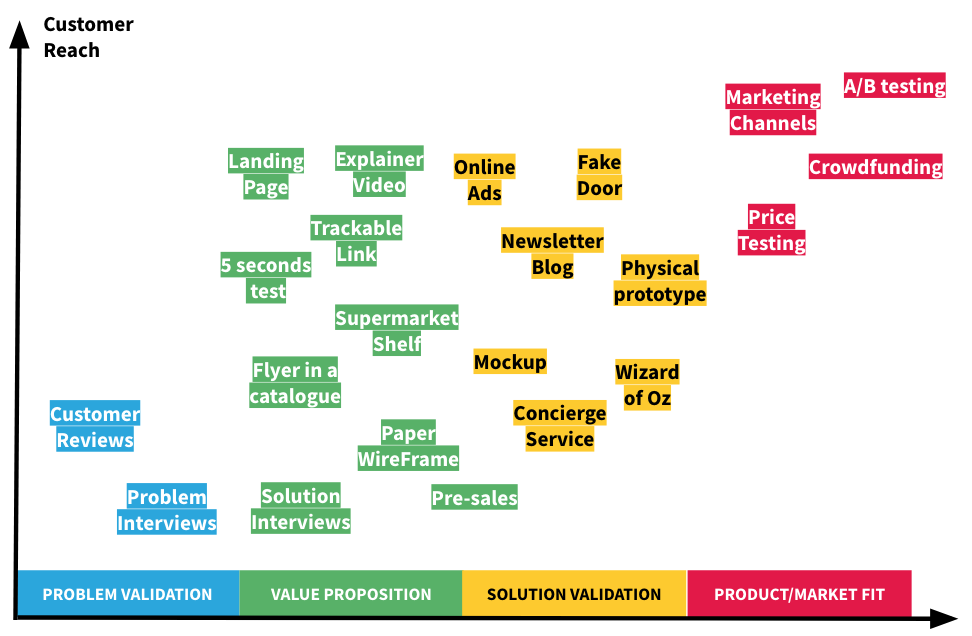You know as an entrepreneur that before building your idea you should build an MVP first, the famous Minimum Viable Product.
So what is this MVP?
This MVP is an experiment to see how customers would react if your idea existed. You will actually build many MVPs and each MVP will help you understand if parts of your idea will work or not, by measuring real customer behaviors.
So what should your MVP look like?
You can test different parts of your idea (price, marketing channels, features, value proposition, user interface, etc…). What you need to test really depends on the advancement stage of your project.
To navigate all the possible experiments you can do, we built a map of the different MVPs, split by advancement stages.
- Problem Validation: making sure you are addressing an important problem for your customers,
- Value Proposition Phase: testing the benefits you want to bring to your customers, is this converting into real value?
- Solution Validation: transforming this value into a tangible product/service, testing its different potential forms.
- Product Market/Fit: testing how large is your market and if you can meet the need.

Here is the detail of each experiment.
PROBLEM VALIDATION TESTS
Problem Interview: Explore your customers’ actual problems, needs and the jobs they really want to be done with qualitative interviews where you do not pitch any solution.
Customer Reviews: Study people comment on competitors’ products. Identify the main pain points they have with these products
VALUE PROPOSITION TESTS
Solution Interview: Pitch your value proposition to customers and if it is something they want, collect some proof of commitment. Something that has cost to your customer: a letter of intent, an engaging meeting, sharing some personal data. Explore what they are willing to give in return for your value proposition.
Pre-Sales: Test your potential customers’ willingness to pay for your solution in advance. A good way to test price sensitivity.
Paper Wireframe: Test the usability of your product with a paper prototype of the designs containing some functional elements. It allows you to understand how people interact with it so you can identify potential problems and unnecessary complexity.
Flyer in a Catalog: Advertise your product with your phone number on the flyer and distribute it into an existing catalog. Measure the number of calls you get.
Supermarket Shelf: To see if your customers will actually buy your product, take a sample packaging of your product to an established supermarket and put it on the shelf. Observe customers interacting with your product. Measure the number of sales you would have accomplished. Stop the customer before they actually buy it, otherwise, they might be disappointed!
5 Seconds Test — Does your target customer understand your offer? Show your value proposition briefly (5 seconds) to your customers and ask them what they understood. You will be surprised how different it can be from what you wanted to convey.
Trackable Link: Place a unique trackable hyperlink in an email and measure whether customers click on it or not. This can give you an indication of the interest in your offer.
Landing Page: A digital standalone webpage created to capture potential customers’ information through a specific call to action. You can contact these customers to ask them what they expect or later when your service is ready.
Explainer Video: Create the impression that your product is already in function and show how it works (as if it was functioning) on a video. Put it on your landing page, post it in the forums or send it by email and see if customers engage with your proposition.
SOLUTION VALIDATION TESTS
Concierge Service: Solve the customer problem, manually, as a service. The customers know that a human is performing the service. For instance, if you want to build a matchmaking app, start by putting people in touch manually. Use the learnings to start automating the process. You will understand how helpful your service is to customers.
Wizard of Oz: Similar to the concierge service, but the customer does not know that a human is providing the service. Use technology to deliver the service manually but make the customer believe the infrastructure is already functioning. That’s how many chatbots started. With minimal development, you are testing if you can solve the customer problem and if the customer is happy with your solution.
Mockup: Built upon the wireframe, a mockup is a draft of your final product that people can interact with. Testing visual elements or specific features help finalize the look and the feel of the product/service.
Physical Prototype: Build a simple physical prototype to test the engagement of your customers. You can build products with very simple materials or using a 3D printer very quickly or a digital prototype.
Newsletter/Blog: Test that you can provide value to your customers by pushing relevant content to their problem. This can be done with a newsletter or blog or a social media platform. This allows you to build your network of early adopters.
Fake Door: On an existing digital product, show to the user an option that doesn’t actually exist yet. When the user clicks, the system lets the user know that the feature is not yet available. Measure how many users are clicking on the feature to decide if it’s worth building.
Online Ads: Target a specific customer segment and test your value proposition. Measure the number of views and the reaction to the call to action.
PRODUCT/MARKET FIT TESTS
Price Testing: Test different prices according to the number of features, your customer target, your positioning, marketing channels. You want to know which price corresponds to your image and which price will prevent your target customers from buying your product.
A/B Testing: A or B? Design an experiment to test both with the same sample of users then use the winning version. Test pricing schemes, the impact of different messages, most relevant channels. Be careful, you need a great volume of testers to validate your assumptions.
Crowdfunding: Validate an idea through crowdfunding platforms. You will be able to generate cash and gauge interest to build your product/service.
If you want to go further, I recommend those articles:
- Do you have a clear hypothesis to evaluate or do you need to generate a clear idea? “Evaluative or Generative” section of The Real Startup Book.
- Strong Evidence / Weak Evidence
And to learn how to think and move like a startup, contact me on Tango.



